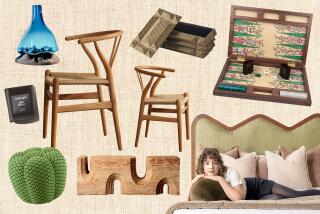How to Find a Decorator You’ll Feel at Home With : Interior design: Interview candidates, look at their work and talk to their past clients.
Have you wondered whether you’d benefit from working with an interior designer? Window & Wall Ideas magazine gives clues on the design process and also tells how to choose a designer who’s right for you.
Although the thought of decorating a home with an interior designer is frightening for many, the key is this: Find the right person and then establish a realistic budget up front.
Skilled interior designers offer expertise in room arrangements andimproving a home’s function, and they know how to use color, texture and pattern to add to a room’s interest. They also can help you avoid expensive mistakes.
An interior designer knows where to search for the right table or the perfect accessory and has access to fabrics and furnishings available only to professionals. Most decorators also can call upon skilled drapery installers, upholsterers, or contractors with whom they work regularly.
To find the interior designer who’s right for you, Ray Kennedy, president of the American Society of Interior Designers, suggests visiting show houses in your area and looking for rooms you love. “Generally the designers are required to be on the premises at least part of the time,” Kennedy says. “If you call ahead, you can meet the designers and see their work.”
Another option is to go to a furniture store or a department store you like, one with a reputation for good customer service. Some have full-fledged design studios with experienced designers on staff.
To ensure that your candidates are not only qualified but also reputable, begin with an interview and a review of the designer’s portfolio. Next, talk to past clients. Ask whether they were satisfied with the work, whether the designer was sensitive to budget considerations, and most important, whether they would hire the designer again.
You should visit other homes the designer has done. Remember, however, that design is very personal. Rather than look for a single house that appears just the way you want yours to, look for an overall style that you like. “Good designers design for you, the client, and not for themselves,” Kennedy says.
Compatibility is a must. You may like a designer’s work, but if you are uncomfortable with the person, forget it.
When interviewing potential designers, be completely honest about your budget. You’ll get the most design for your money if you tell the truth about what you can afford to spend. A good interior designer will tell you if your budget is realistic and what can be accomplished for that amount of money.
If purse strings are tight, a sympathetic designer will offer cost-cutting strategies. If you want to save money, or if you simply enjoy taking on such tasks as painting, stenciling, wallpapering or staining, ask if you can do that work yourself.
Ask before you hire the designer. This way, your contributions can be worked into the budget and the schedule from the beginning. Keep in mind that most interior designers prefer to work with their own subcontractors, which include installers, painters, carpenters and electricians whose work they’re familiar with.
If your budget is truly small--in the $500 to $2,500 range--you’d probably be better off hiring a designer simply as a consultant. The designer can prepare drawings, outline furniture purchases, select fabrics and colors and then you can implement the plans.
Traditionally, residential interior designers have made their money by charging clients a 30% to 40% markup on all furnishings purchased on their behalf. According to Kennedy, however, more designers have begun to bill an hourly rate for their services. This is often the case if you hire a decorator as a consultant. Some decorators charge a mixture of the two, working on an hourly rate during the design phase and then charging a markup on purchases.
Still other designers charge a flat fee for the entire project. A few charge by the square foot, but generally only commercial designers operate this way. A more common approach is to bill as a percentage of the entire job. The charge usually ranges from 15% to 35%.
Design studios linked with furniture stores and department stores require that you buy a certain amount of furnishings from the store.
Once you’ve chosen an interior designer, insist on a contract or letter of agreement that outlines payment procedures and schedules and describes in detail the work to be done, the budget and an estimated time frame.
How long the decorating of your house or apartment takes depends on what you need done, as well as the order time for the furnishings. To avoid disappointment, expect everything to take longer than you think it will.
Many people choose to stretch out their decorating over a period of several years. Most interior designers are happy to work out a long-term decorating plan. Tell potential candidates the time frame that you have in mind. By taking a long-term approach to decorating your home, you are likely to get more design for your money.
More to Read
Sign up for Essential California
The most important California stories and recommendations in your inbox every morning.
You may occasionally receive promotional content from the Los Angeles Times.






